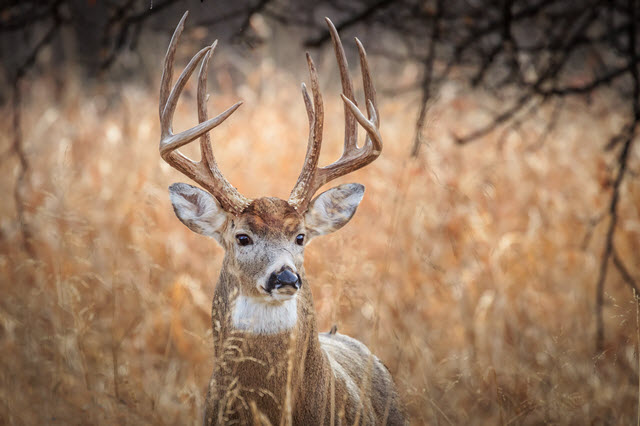A female deer is a doe, while a young deer is called either a fawn, kid, or calf. But what is a male deer called? Male cervids go by several names, and the correct name for a male deer depends on their species, build, and physical features. The part of the world they live in can also play a role in determining what people call male deer.
Let’s get started with the basic terminology.
What is a Male Deer Called? (4 common names)
Table of Contents
ToggleMale deer are usually called one of 4 common names. These include: Buck, Stag, Bull, and Hart.
- “Buck” is the most common name for a male deer, and small or medium-sized male deer are typically referred to as bucks.
- “Stag” is a term often used for larger male deer with big and impressive racks of antlers, such as the Red Deer in Europe or the Sika Deer in Asia.
- “Bull” is a term reserved for the largest deer species (Moose, North American Elk, Reindeer, etc.), and finally
- “Hart” is an older English term for male cervids that was most commonly used in Medieval times.

Now, let’s take a closer look at each of the most common names for male deer.
About Male Deer Called a Buck
Buck is a universally accepted term for a male deer, whether mature or immature. However, it is also used in calling males of other animal groups, including rabbits, hares, antelopes, goats, and sometimes sheep.
Male deer such as the White-Tailed Deer, Roe Deer, Muntjac Deer and Mule Deer are often called bucks by hunters and wildlife biologists.

Here’s a bit more information on each of these species of deer:
Male White-Tailed Deer Characteristics
White-tailed deer are medium-sized deer common in the woodlands of southern Canada and in the mainland United States (except in Alaska and Hawaii). The most distinct feature of white-tailed deer is the strip of white color on their under-tail, which is highly visible in contrast to their reddish-brown coat.
White Tailed Deer Bucks typically weigh at least 150 pounds to 300 pounds. Bambi, the famous Disney cartoon character, was fashioned after a white-tailed deer.
Learn More About White-Tailed Deer
Male Roe Deer Characteristics
The Roe deer is native to the woodlands, farmlands, and grasslands of the United Kingdom. Bucks have small antlers, growing up to 10 inches with two or three points. During the rut season, bucks make a sound that resembles barking like dogs or whining like coyotes to catch the attention of female roe deer.
Roe deer can weigh between 30 and 75 pounds, with males weighing 20 pounds heavier than females.
Learn More About European Roe Deer
Male Muntjac Deer Characteristics
Muntjac deer are a smaller deer species native to southern and south-eastern Asia. Muntjac bucks have small antlers that curve backwards and don’t branch out.
Bucks typically have a V-shaped facial mark that distinguishes them from the heart-shaped marking that does have.
Learn More About Muntjac Deer Species
Male Mule Deer Characteristics
Mule deer find their home in western parts of the US. They earned their name because they have have large mule-like ears that grow to be as much as three-fourths of their head size.
The antlers of Mule Deer bucks branch off, forming at least two tines each, and this species is prized by many hunters in North America.
About Male Deer Called Stags
An adult or mature male deer can also be called a stag. Often, the term stag refers to a deer with a bigger build and larger antlers.

Because of their heavy frame, stags are typically stronger than bucks. They also are also more hostile when competing for the attention of female deer.
Some examples of stags are the Red Deer and Sika Deer.
Male Red Deer Characteristics
Red deer is hailed as the largest species of deer in the UK and most of Europe. Red Deer Stags can weigh over 400 pounds and stand at a shoulder up to four feet tall. Their antlers are highly branched and can grow over 16 points.
The Red Deer is called a Royal Stag if it has a 12-point antler (six on each side), an Imperial stag if there are 14 points, and a Monarch if the antler is over 16 points.
Learn More About the Red Deer Species
Male Sika Deer Characteristics
Found in eastern Asia and then introduced into Europe in the late 1800s, the Sika Deer is similar to the red deer but has a smaller build.
Sika Deer Stags grow antlers that can have up to eight points and weigh up to 90 pounds.
About Male Deer Called Bulls
Males of larger deer species such as the North American Elk (wapiti), Moose, and Caribou or Reindeer are often referred to as bulls.

The term bull is also used in describing the masculine gender of large animal groups, including cattle, bison, and water buffalo.
Male Elk Characteristics
Bull Elk (Wapiti) produce the largest antlers, growing up to eight points on each side. The length of an elk’s antlers can reach up to four feet long and weigh about 20 pounds each.
Adult elk males can weigh as much as 1,000 pounds.
Male Moose (North America) Characteristics
The North American Moose is found in Canada and Alaska and some northern states in the US (such as Maine, which has the highest concentration of Moose in the US outside of Alaska).
They stand a staggering 7 feet tall, making them the largest member of the deer family. In Europe, the Alces alces species is referred to as the Elk, while in North America the Wapiti Deer is known as the elk, which can lead to some confusion.
Male Caribou Characteristics
Both male and female caribou deer have antlers. The bull’s antlers branch out whilst the female’s antlers grow straight and are used for digging for forage in snow.
In the United States, Caribou can be found inhabiting Alaska, Idaho, and Montana. This species is also present in Canada and northern parts of Asia and Europe, where it is more frequently referred to as Reindeer.
About Male Deer Referred to as Harts
Hart is the old English term for the word “stag.” It may be commonly observed in literature, and was used during medieval times as the name for a Red Deer stag that is older than five years.
While it isn’t a name that is used as commonly these days, it has strong historical usage, and is worth mentioning along with the primary three names for male cervids.
Frequently Asked Questions About Male Deer Names
What is a male deer called? Now you know: a Buck, Stag, Bull, or Hart. But you may still have some questions about which name to use for different deer, and when to use it.

Here are some answers to common questions on the topic:
Can You Use Buck, Stag, Bull, and Hart Interchangeably?
There is really no clear-cut rule.
But typically, all male deer may be called bucks, regardless of the deer’s age, build, or antler size. A male with a large build may be more appropriately called a stag or a bull depending on the species.
Meanwhile, the archaic term “hart” is rarely ever used today. We mention it mostly due to its historical usage in literature.
Do All Male Deer Have Antlers?
Male deer, except for the water deer native to Korea and China, typically have antlers. These water deer species develop large canine teeth which resemble fangs instead.
The size of a male deer’s antlers depends on its age. In most cases, the older the deer is, the bigger its antlers are.
Factors such as genetics and diet can also affect antler growth.
Do Male Deer Shed Their Antlers?
Most males – like the elk, moose, and caribou – shed their antlers annually, after the rut or breeding season.
It typically takes two weeks after shedding before a new set of antlers begins to grow.
Antlers are some of the fastest-growing tissue amongst mammals, increasing about one inch each day and covered in velvet until they shed that soft coating in preparation for the annual rut.
Antlers and horns are different in several ways, and deer are the only species of animals that grow antlers.




